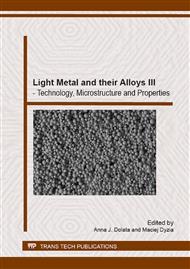[1]
K.E. Oczoś, A. Kawalec, Light metals forming, Wydawnictwo Naukowe PWN, Warszawa, 2012 (in Polish).
Google Scholar
[2]
A. Kiełbus, D. Kuc, T. Rzychoń, Magnesium alloys – microstructure, properties and application. Monograph. Modern metallic materials - presence and future. Department of Materials Engineering and Metallurgy, Katowice, 2009 (in Polish).
Google Scholar
[3]
S. Rusz, L. Čížek, L.A. Dobrzański, S. Tylšar, J. Kedroň, ECAP methods application on selected non-ferrous metals and alloys, Archives of Materials Science and Engineering 43 (2010) 69-76.
DOI: 10.4028/www.scientific.net/msf.782.404
Google Scholar
[4]
M. Ullmann, H. Saleh, M. Schmitdchen, R. Kawalla, H.P. Vogt, Improvement of ductility for Twin Roll Cast and rolled AZ31 strips by use of Taguchi method, Archives of Civil and Mechanical Engineering 13 (2013) 1-6.
DOI: 10.1016/j.acme.2012.09.001
Google Scholar
[5]
A. Gontarz, Z. Pater, K. Drozdowski, Hammer forging process of lever drop forging from AZ31 magnesium alloy, Metalurgija 52 (2013) 359-362.
Google Scholar
[6]
W. Walke, E. Hadasik, J. Przondziono, D. Kuc, I. Bednarczyk, G. Niewielski, Plasticity and corrosion resistance of magnesium alloy WE43, Archives of Materials Science and Engineering 51 (2011) 16-24.
Google Scholar
[7]
Z. Cyganek, M. Tkocz, The effect of AZ31 alloy flow stress description on the accuracy of forward extrusion FE simulation results, Archives of Metallurgy and Materials 57 (2012) 199-204.
DOI: 10.2478/v10172-012-0010-y
Google Scholar
[8]
J. Tomczak, Z. Pater, T. Bulzak, Thermo-mechanical analysis of a lever preform forming from magnesium alloy AZ31, Archives of Metallurgy and Materials 57 (4) (2012) 1211-1218.
DOI: 10.2478/v10172-012-0135-z
Google Scholar
[9]
E. Hadasik, D. Kuc, T. Mikuszewski, Plasticity and microstructure of Mg-Li alloys, Hutnik. Wiadomości Hutnicze 78 (2011) 617-621 (in Polish).
Google Scholar
[10]
W. Walke, J. Przondziono, E. Hadasik, J. Szala, D. Kuc, Corrosion resistance of AZ31 alloy after plastic working in NaCl solutions. Journal of Achievements in Materials and Manufacturing Engineering 45 (2011) 132-140.
DOI: 10.1088/1757-899x/22/1/012017
Google Scholar
[11]
G. Song, A. Atrens, X. Wu, B. Zhang, Corrosion behaviour of AZ21, AZ501 and AZ91 in sodium chloride, Corrosion Science 40 (1998) 1769-1791.
DOI: 10.1016/s0010-938x(98)00078-x
Google Scholar
[12]
G. Song, A. Atrens, Corrosion mechanisms of magnesium alloys, Advanced Engineering Materials 1 (1999) 11-33.
Google Scholar
[13]
J. Przondziono, W. Walke, E. Hadasik, B. Jasiński, Electrochemical corrosion of magnesium alloy AZ31 in NaCl solutions, Acta Metallurgica Slovaca 16 (2010) 254-260.
DOI: 10.1007/978-3-030-15472-1_30
Google Scholar
[14]
J. Przondziono, W. Walke, E. Hadasik, J. Szala, J. Wieczorek, Corrosion resistance tests of magnesium alloy WE43 after extrusion, Metalurgija 52 (2) (2013) 242-246.
DOI: 10.4028/www.scientific.net/kem.607.31
Google Scholar
[15]
G. Song, A. Atrens, Understanding Magnesium Corrosion - A Framework for Improved Alloy Performance, Advanced Engineering Materials 5 (2003) 837-858.
DOI: 10.1002/adem.200310405
Google Scholar
[16]
J. Przondziono, W. Walke, A. Szuła, E. Hadasik, J. Szala, J. Wieczorek, Resistance to corrosion of magnesium alloy AZ31 after plastic working, Metalurgija 50 (2011) 239-243.
DOI: 10.4028/www.scientific.net/ssp.227.35
Google Scholar
[17]
A.J. Dolata, M. Dyzia, W. Walke, Influence of particles type and shape on the corrosion resistance of aluminium hybrid composites, Solid State Phenomena 191 (2012) 81-87.
DOI: 10.4028/www.scientific.net/ssp.191.81
Google Scholar


